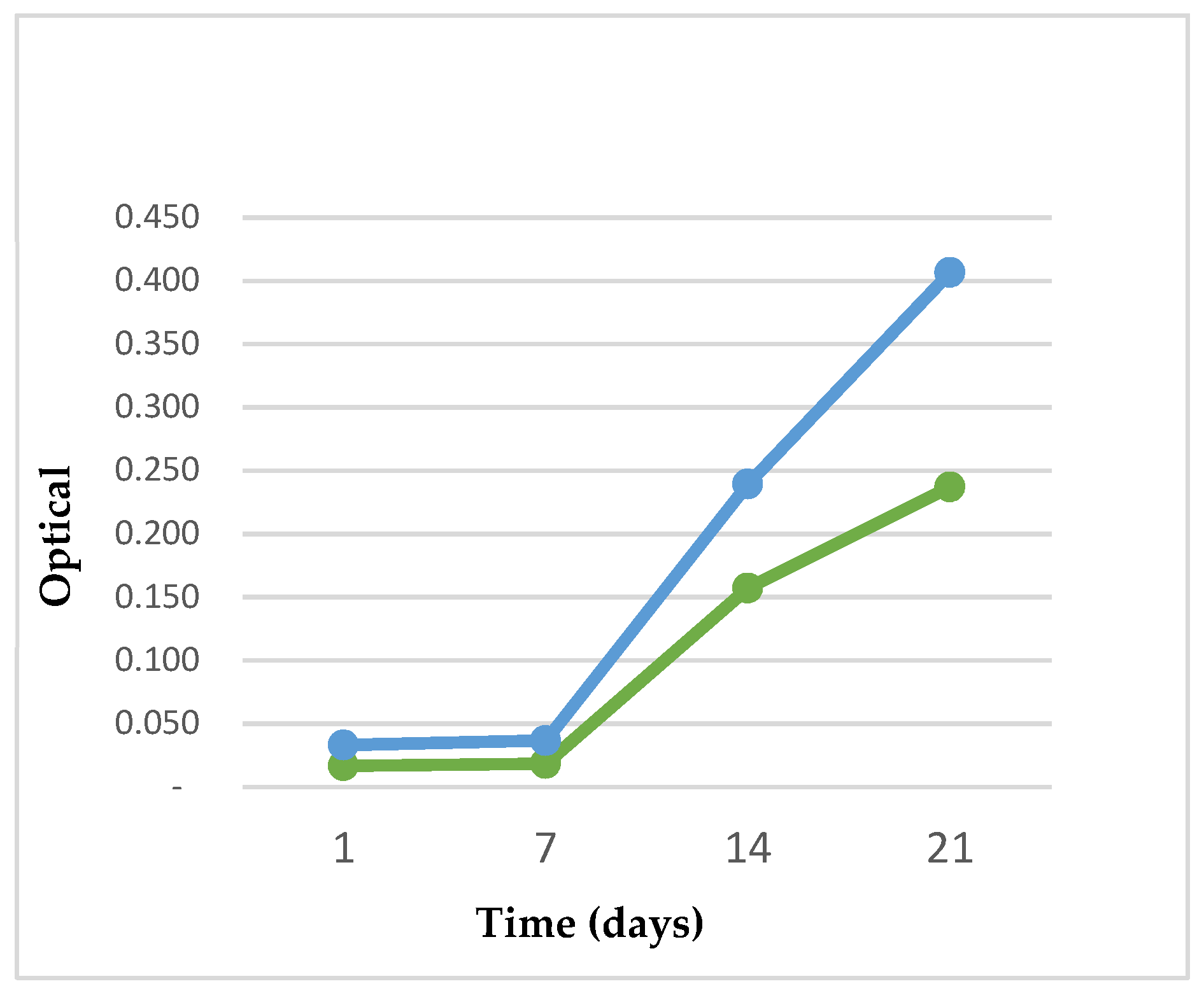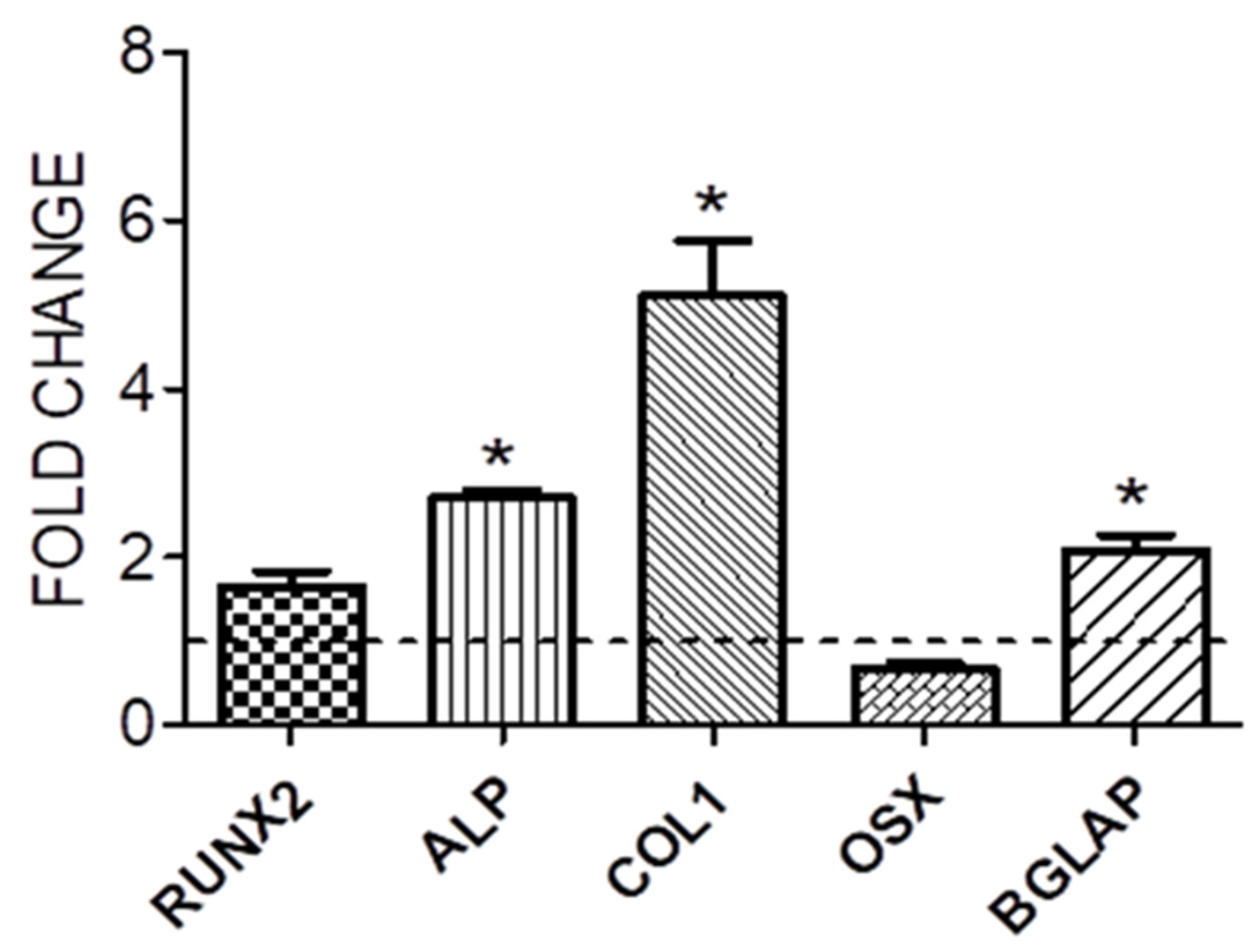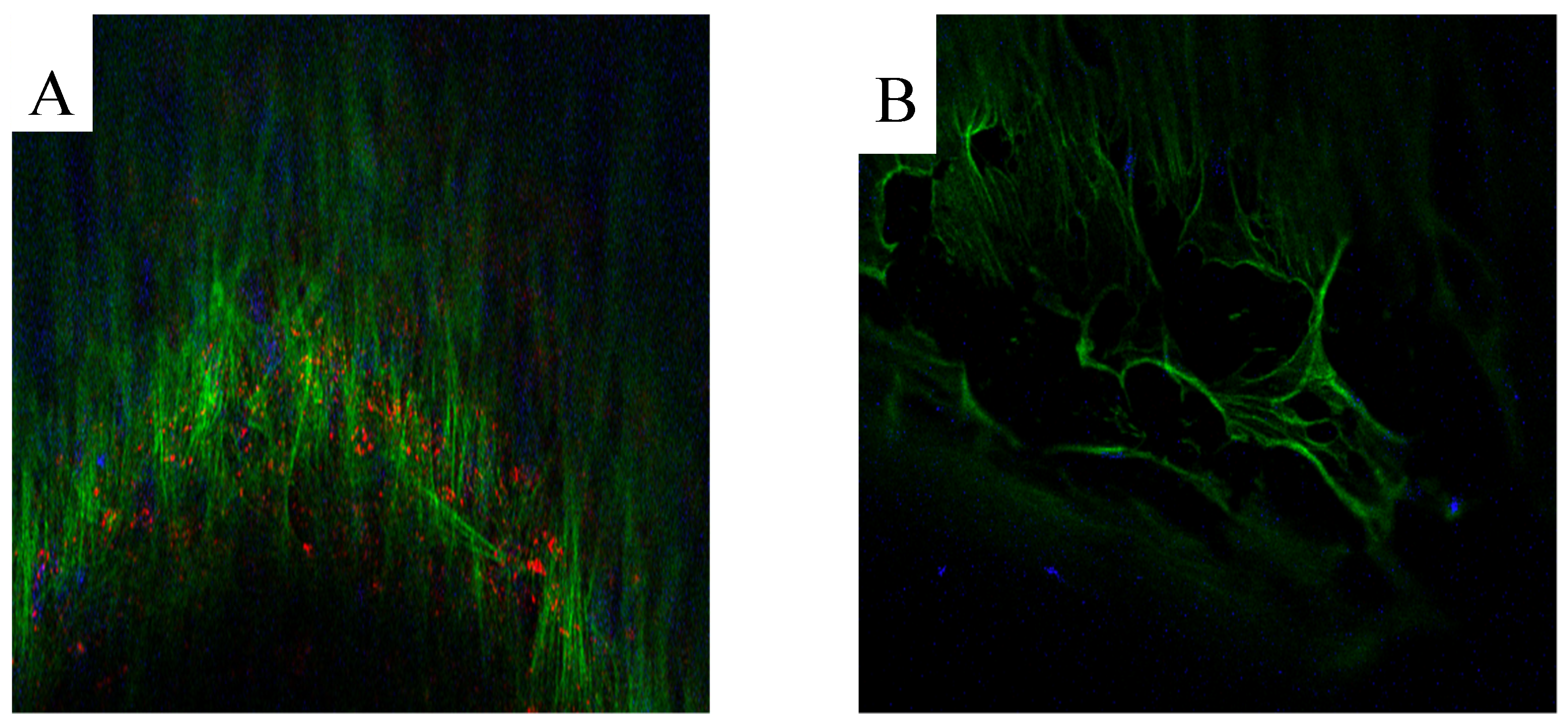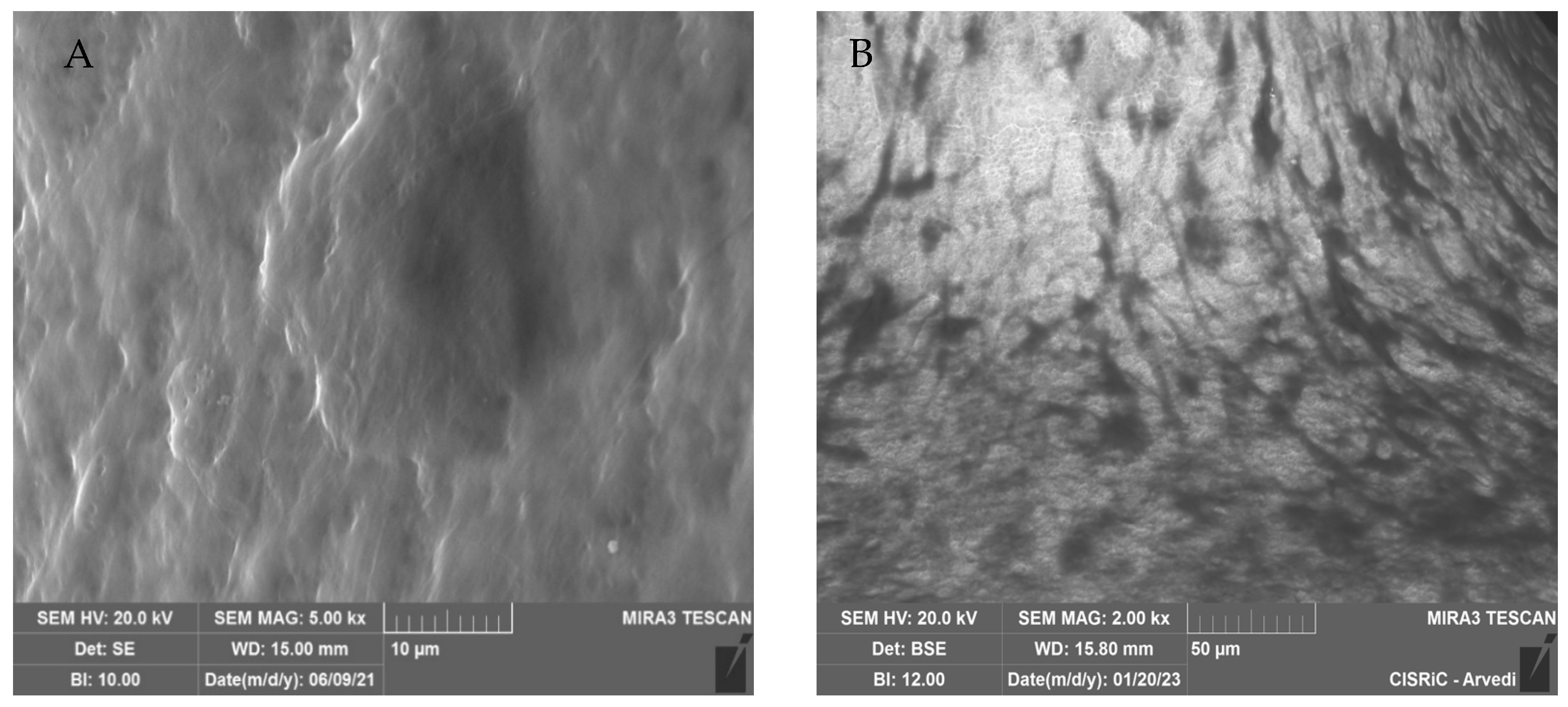Titanium Biohybrid Middle Ear Prostheses: A Preliminary In Vitro Study
Abstract
:1. Introduction
2. Materials and Methods
2.1. Production of Titanium Biohybrid Middle Ear Prostheses
2.2. Titanium Biohybrid Middle Ear Prostheses Analyses
2.2.1. Cell Proliferation and Osteogenic Differentiation
2.2.2. Production of Extracellular Matrix
3. Results
3.1. Cell Proliferation and Osteogenic Differentiation
3.2. Production of Extracellular Matrix
4. Discussion
5. Conclusions
Author Contributions
Funding
Institutional Review Board Statement
Informed Consent Statement
Data Availability Statement
Acknowledgments
Conflicts of Interest
References
- Kortebein, S.; Russomando, A.C.; Greda, D.; Cooper, M.; Ledbetter, L.; Kaylie, D. Ossicular chain reconstruction with titanium prostheses: A systematic review and meta-analysis. Otol. Neurotol. 2023, 44, 107–114. [Google Scholar] [CrossRef] [PubMed]
- Kim, H.; Ha, J.; Choo, O.S.; Park, H.; Choung, H.K. Which is better for ossiculoplasty following tympanomastoidectomy: Polycel® or Titanium? Ann. Otol. Rhinol. Laryngol. 2023, 132, 000348942311599. [Google Scholar] [CrossRef] [PubMed]
- Faramarzi, M.; Roosta, S.; Faramarzi, A.; Khera, M. Comparison of partial vs. total ossicular chain reconstruction using titanium prosthesis: A retrospective cohort study. Eur. Arch. Otorhinolaryngol. 2023, 280, 3567–3575. [Google Scholar] [CrossRef] [PubMed]
- Carey, J.; Gabbireddy, S.; Mammen, L.; Rosamilia, G.; Patel, V.; Foyt, D.; Parnes, S. FDA MAUDE database analysis of titanium middle ear prosthesis. J. Otol. 2022, 17, 18–24. [Google Scholar] [CrossRef] [PubMed]
- Mudhol, R.S.; Naragund, A.I.; Shruthi, V.S. Ossiculoplasty: Revisited. Indian J. Otolaryngol. Head Neck Surg. 2013, 65 (Suppl. S3), 451–454. [Google Scholar] [CrossRef] [PubMed]
- Yu, Z.; Zhang, L.; Han, D. Long-term outcome of ossiculoplasty using autogenous mastoid cortical bone. J. Laryngol. Otol. 2014, 128, 866–870. [Google Scholar] [CrossRef]
- Hajela, A.; Kumar, S.; Singh, H.P.; Verma, V. Comparison of Ossiculoplasty Using Autograft Ossicle Versus Allograft (Teflon). Indian J. Otolaryngol. Head Neck Surg. 2019, 71 (Suppl. S2), 1309–1313. [Google Scholar] [CrossRef]
- Zhang, L.C.; Zhang, T.Y.; Dai, P.; Luo, J. Titanium versus non-titanium prostheses in ossiculoplasty: A meta-analysis. Acta Otolaryngol. 2011, 131, 708–715. [Google Scholar] [CrossRef]
- Beutner, D.; Hüttenbrink, K.B. Passive and active middle ear implants. GMS Curr. Top. Otorhinolaryngol. Head Neck Surg. 2009, 8, Doc09. [Google Scholar] [CrossRef]
- Sanna, M.; Hiroshi, S.; Mancini, F.; Russo, A.; Taibah, A.; Falcioni, M. Middle Ear and Mastoid Microsurgery; Thieme: Stuttgart, Germany, 2018; pp. 187–244. [Google Scholar]
- Dalchow, C.V.; Grün, D.; Stupp, H.F. Reconstruction of the ossicular chain with titanium implants. Otolaryngol. Head Neck Surg. 2001, 125, 628–630. [Google Scholar] [CrossRef]
- Coffey, C.S.; Lee, F.; Lambert, P.R. Titanium versus nontitanium prostheses in ossiculoplasty. Laryngoscope 2008, 118, 1650–1658. [Google Scholar] [CrossRef] [PubMed]
- Kálmán, J.; Horváth, T.; Liktor, B.; Dános, K.; Tamás, L.; Gődény, M.; Polony, G. Limitations of non-echo planar diffusion weighted magnetic resonance imaging (non-EPI MRI) in cholesteatoma surveillance after ossicular chain reconstruction. A prospective study. Auris Nasus Larynx. 2021, 48, 630–635. [Google Scholar] [CrossRef] [PubMed]
- Danti, S.; Stefanini, C.; D’Alessandro, D.; Moscato, S.; Pietrabissa, A.; Petrini, M.; Berrettini, S. Novel biological/biohybrid prostheses for the ossicular chain: Fabrication feasibility and preliminary functional characterization. Biomed. Microdev. 2009, 11, 783–793. [Google Scholar] [CrossRef] [PubMed]
- Danti, S.; D’Alessandro, D.; Pietrabissa, A.; Petrini, M.; Berrettini, S. Development of tissue-engineered substitutes of the ear ossicles: PORP-shaped Poly(Propylene Fumarate)-based scaffolds cultured with human mesenchymal stromal cells. J. Biomed. Mater. Res. 2009, 92, 1343–1356. [Google Scholar] [CrossRef]
- Caliogna, L.; Bina, V.; Botta, L.; Benazzo, F.M.; Medetti, M.; Maestretti, G.; Mosconi, M.; Cofano, F.; Tartara, F.; Gastaldi, G. Osteogenic potential of human adipose derived stem cells (hASCs) seeded on titanium trabecular spinal cages. Sci. Rep. 2020, 10, 18284. [Google Scholar] [CrossRef] [PubMed]
- Huang, X.; Das, R.; Patel, A.; Duc Nguyen, T. Physical stimulations for bone and cartilage regeneration. Regen. Eng. Transl. Med. 2018, 4, 216–237. [Google Scholar] [CrossRef]
- Canzi, P.; Berrettini, S.; Albera, A.; Barbara, M.; Bruschini, L.; Canale, A.; Carlotto, E.; Covelli, E.; Cuda, D.; Dispenza, F.; et al. Current trends on subtotal petrosectomy with cochlear implantation in recalcitrant chronic middle ear disorders. Acta Otorhinolaryngol. Ital. 2023, 43, S67–S75. [Google Scholar] [CrossRef] [PubMed]
- Park, S.; Lim, K.H.; Lim, S.J.; Park, D.H.; Rah, Y.C.; Choi, J. Functional outcomes of single-stage ossiculoplasty in chronic otitis media with or without cholesteatoma. J. Int. Adv. Otol. 2022, 18, 415–419. [Google Scholar] [CrossRef]
- Kong, J.S.; Jeong, C.Y.; Shim, M.J.; Kim, W.J.; Yeo, S.W.; Park, S.N. Comparative study of new autologous material, bone-cartilage composite graft, for ossiculoplasty with Polycel® and Titanium. Clin. Otolaryngol. 2018, 43, 434–439. [Google Scholar] [CrossRef]
- Van Rompaey, V.; Farr, M.R.B.; Hamans, E.; Mudry, A.; Van De Heyning, P.H. Allograft tympanoplasty: A historical perspective. Otol. Neurotol. 2013, 34, 180–188. [Google Scholar] [CrossRef]
- Mardassi, A.; Deveze, A.; Sanjuan, M.; Mancini, J.; Parikh, B.; Elbedeiwy, A.; Magnan, J.; Lavieille, J.P. Titanium ossicular chain replacement prostheses: Prognostic factors and preliminary functional results. Eur. Ann. Otorhinolaryngol. Head Neck Dis. 2011, 128, 53–58. [Google Scholar] [CrossRef] [PubMed]
- Canzi, P.; Carlotto, E.; Bruschini, L.; Minervini, D.; Mosconi, M.; Caliogna, L.; Ottoboni, I.; Chiapperini, C.; Lazzerini, F.; Forli, F.; et al. Extrusion and Dislocation in Titanium Middle Ear Prostheses: A Literature Review. Brain Sci. 2023, 13, 1476. [Google Scholar] [CrossRef] [PubMed]
- Quaranta, N.; Fernandez-Vega Feijoo, S.; Piazza, F.; Zini, C. Closed tympanoplasty in cholesteatoma surgery: Long-term (10 Years) hearing results using cartilage ossiculoplasty. Eur. Arch. Otorhinolaryngol. 2001, 258, 20–24. [Google Scholar] [CrossRef] [PubMed]
- Pham, Q.P.; Kasper, F.K.; Scott Baggett, L.; Raphael, R.M.; Jansen, J.A.; Mikos, A.G. The influence of an in vitro generated bone-like extracellular matrix on osteoblastic gene expression of marrow stromal cells. Biomaterials 2008, 29, 2729–2739. [Google Scholar] [CrossRef]
- Subramaniam, M.; Pitel, K.S.; Withers, S.G.; Drissi, H.; Hawse, J.R. TIEG1 enhances Osterix expression and mediates its induction by TGFβ and BMP2 in osteoblasts. Biochem. Biophys. Res. Commun. 2016, 470, 528–533. [Google Scholar] [CrossRef]
- Grottkau, B.E.; Lin, Y. Osteogenesis of adipose-derived stem cells. Bone Res. 2013, 1, 133–145. [Google Scholar] [CrossRef]
- Majidinia, M.; Sadeghpour, A.; Yousefi, B. The roles of signaling pathways in bone repair and regeneration. J. Cell Physiol. 2018, 233, 2937–2948. [Google Scholar] [CrossRef]
- Barberi, J.; Spriano, S. Titanium and protein adsorption: An overview of mechanisms and effects of surface features. Materials 2021, 14, 1590. [Google Scholar] [CrossRef]
- Tiwari, D.; Vobilisetty, R.K.; Heer, B. Current Application and Future Prospects of 3D Printing in Otorhinolaryngology—A Narrative Review. Indian J. Otolaryngol. Head Neck Surg. 2022, 74, 123–126. [Google Scholar] [CrossRef]
- Dai, R.; Wang, Z.; Samanipour, R.; Koo, K.I.; Kim, K. Adipose-derived stem cells for tissue engineering and regenerative medicine applications. Stem Cells Int. 2016, 2016, 6737345. [Google Scholar] [CrossRef]






| Gene | Target Transcript | Quantitect Primer Assay (Quiagen) | Amplicon Length |
|---|---|---|---|
| ALP | NM_000478 | QT00012957 | 110 bp |
| RUNX-2 | NM_001015051 | QT00020517 | 102 bp |
| COL1A1 | NM_000088 | QT00037793 | 127 bp |
| OSX | NM_152860 | QT00213514 | 120 pb |
| BGLAP | NM_199173 | QT00232771 | 90 pb |
| β2M | NM_004048 | QT00088935 | 98 pb |
Disclaimer/Publisher’s Note: The statements, opinions and data contained in all publications are solely those of the individual author(s) and contributor(s) and not of MDPI and/or the editor(s). MDPI and/or the editor(s) disclaim responsibility for any injury to people or property resulting from any ideas, methods, instructions or products referred to in the content. |
© 2023 by the authors. Licensee MDPI, Basel, Switzerland. This article is an open access article distributed under the terms and conditions of the Creative Commons Attribution (CC BY) license (https://creativecommons.org/licenses/by/4.0/).
Share and Cite
Mosconi, M.; Carlotto, E.; Caliogna, L.; Berni, M.; Gastaldi, G.; Conti, M.; Brancato, A.M.; Bina, V.; Minervini, D.; Malpede, S.; et al. Titanium Biohybrid Middle Ear Prostheses: A Preliminary In Vitro Study. J. Funct. Biomater. 2023, 14, 561. https://doi.org/10.3390/jfb14120561
Mosconi M, Carlotto E, Caliogna L, Berni M, Gastaldi G, Conti M, Brancato AM, Bina V, Minervini D, Malpede S, et al. Titanium Biohybrid Middle Ear Prostheses: A Preliminary In Vitro Study. Journal of Functional Biomaterials. 2023; 14(12):561. https://doi.org/10.3390/jfb14120561
Chicago/Turabian StyleMosconi, Mario, Elena Carlotto, Laura Caliogna, Micaela Berni, Giulia Gastaldi, Michele Conti, Alice Maria Brancato, Valentina Bina, Domenico Minervini, Stefano Malpede, and et al. 2023. "Titanium Biohybrid Middle Ear Prostheses: A Preliminary In Vitro Study" Journal of Functional Biomaterials 14, no. 12: 561. https://doi.org/10.3390/jfb14120561
APA StyleMosconi, M., Carlotto, E., Caliogna, L., Berni, M., Gastaldi, G., Conti, M., Brancato, A. M., Bina, V., Minervini, D., Malpede, S., Stellato, A. C., Lazzerini, F., Bruschini, L., Benazzo, M., & Canzi, P. (2023). Titanium Biohybrid Middle Ear Prostheses: A Preliminary In Vitro Study. Journal of Functional Biomaterials, 14(12), 561. https://doi.org/10.3390/jfb14120561







